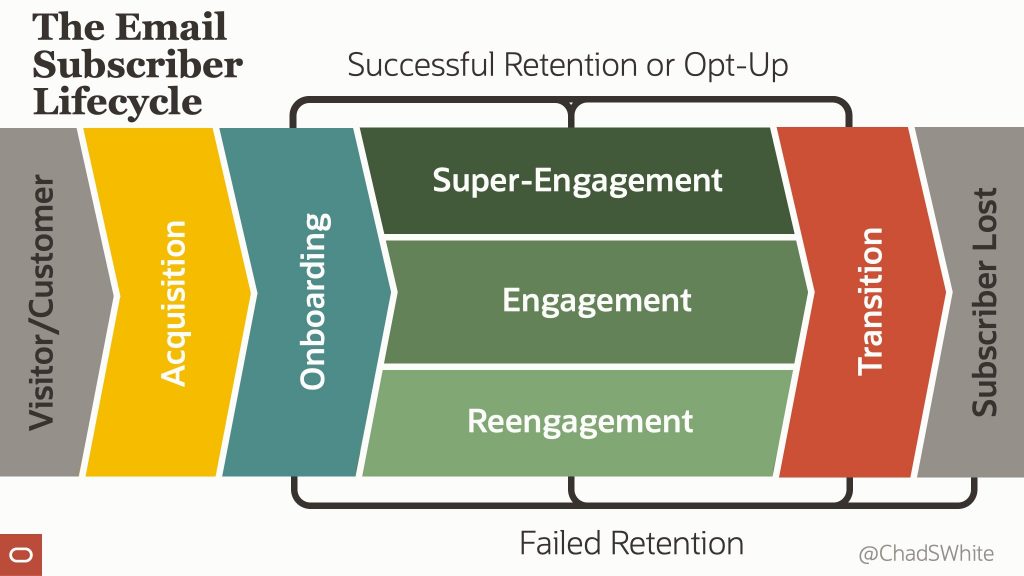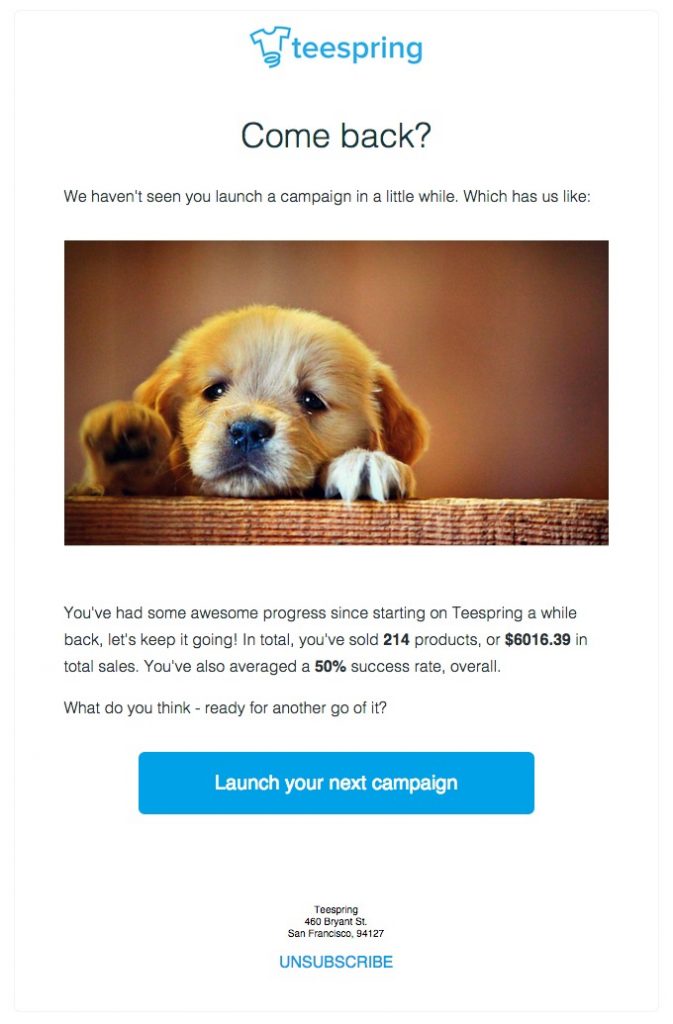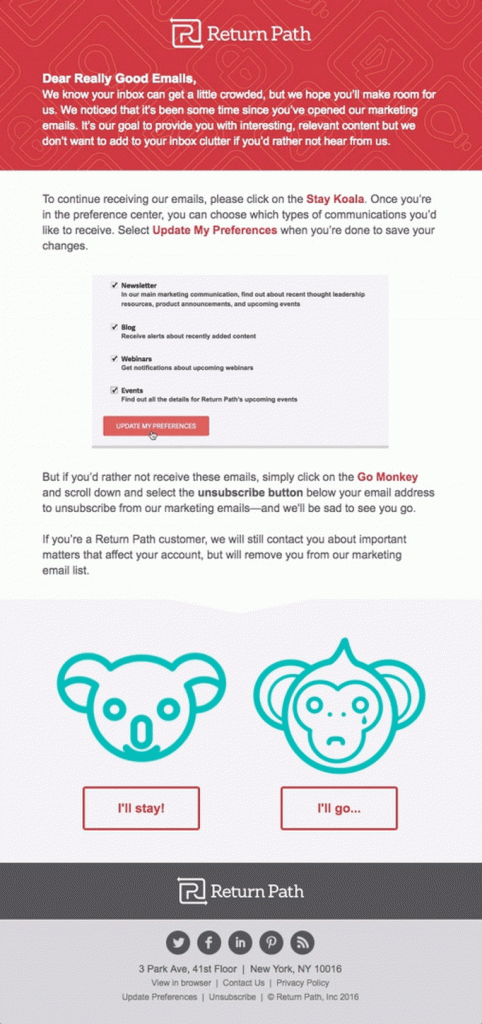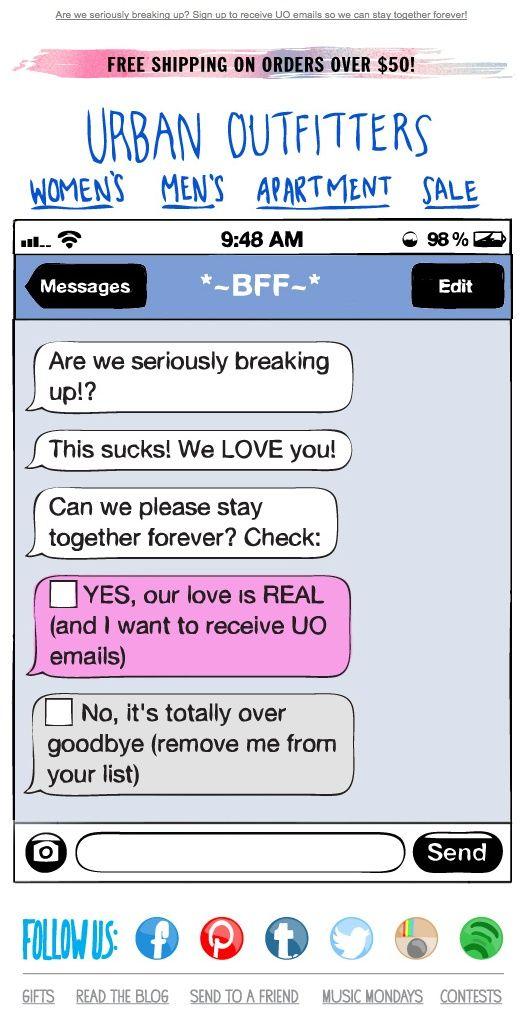There are three key reasons why it may be time to say goodbye to inactive subscribers:
- Decreased ROAS: The bigger your email marketing list is, the higher your email marketing platform costs will be. Higher costs, combined with reduced engagement, mean reduced ROAS.
- Decreased deliverability: The more inactive email subscribers you have in your segments, the more deliverability will be affected, hurting list quality over time.
- Waste of valuable resources: Putting effort into segments that have no intention of buying is a waste of resources. It is far better to invest time, creative effort, and budget into groups of potential customers that are more likely to convert.
The bottom line is that unengaged subscribers have a negative impact on your email engagement rates. Culling them seems like a no-brainer. However, when you’ve worked so hard to build your list, it’s not so cut and dried. There is a right and wrong way to do it.
It is common practice to either just delete inactive subscribers without much investigation or to ignore them entirely, leaving them on subscriber lists indefinitely.
However, this is too simplistic when you consider that many of these unengaged subscribers were once interested in your store and could be encouraged onto your active customer list. The trick is taking a closer look at the data.
To do this, you will want to:
- Identify inactive subscribers based on your key eCommerce email marketing KPIs.
- Segment these subscribers into crucial groups that you can delete or use for win-back campaigns.
In this post, we will show how to do just this in four steps.
Step 1: Define “Active Subscribers” Criteria for Your Store
Before you delete unengaged subscribers, you need to determine what unengaged means for your store brand and in terms of your business goals. This means analyzing engagement data, setting specific KPIs, and creating a brand-specific subscriber lifecycle. This ensures you have the entire behavior landscape before marking email subscribers as inactive.
[Source: Oracle]
You will want to determine the average amount of time or email frequency after which subscribers become inactive. If, for example, you have a short subscriber and product lifecycle, you may evaluate failed retention at five email campaigns in 60 days.
Here are some ways to measure the amount of time and activity for your brand from the following engagements:
- Last email read
- Subscription date
- Last purchase
- Last link click
- Last store visit
Step 2: Segment Inactive Subscribers Into Key Types
Once you have determined activity benchmarks to decide whether subscribers are engaged or not, it’s time to dig deeper into segmenting unengaged subscribers. Why is this important? Because not all inactive subscribers are created equally, so they should be addressed in different ways.
There are three main types of unengaged subscribers, based on behavior or lack thereof. Let’s look at each in more detail.
Inactive Subscriber Type #1: Ghosts
Ghost or dead subscribers are those that have never been active. In other words, they signed up and never read, opened, clicked, or engaged with your eCommerce marketing in any way. These types of inactive subscribers are the most significant email marketing ROAS killers of the lot.
So what to do with email subscriber ghost segments? Kick them to the curb!
This is one segment of email marketing unengaged subscribers you should say goodbye to ASAP. The chances of re-engaging this segment, even with the most convincing re-engagement campaigns, are very slim, and they are ultimately costing you money and skewing your metrics.
Inactive Subscriber Type #2: Sleepers
Sleepy subscribers are inactive subscribers who started off very active, then more recently suddenly went quiet.
Bonus Content: 9 Winning eCommerce Email Campaigns You Should Borrow Today!
These types of inactive subscriber segments still have some conversion potential. This means you don’t want to delete them just yet, as a well-strategized win-back campaign could re-engage them.
[Source: CampaignMonitor]
Bonus Tip: Set up automatic email triggers for win-back re-engagement campaigns based on activity metrics and time frames using your “Active Subscribers” criteria as highlighted in step one! But bear in mind that, like with any marketing, you want to segment as much as possible to ensure that your win-back campaigns are as personalized as possible.
Inactive Subscriber Type #3: Dormant
Dormant subscribers are unengaged users who were once very active. However, over an extended period of time, they haven’t engaged with your store or email marketing in any way. Unlike sleepers, their engagement has been declining or non-existent for some time, and the chances of them becoming fully engaged have diminished.
You will want to segment these subscribers so that you can slowly decrease emails to this user group. For example, if you’re sending weekly product mails, switch to bi-weekly, then monthly. After a certain amount of time, if there is still no engagement, remove them from your subscriber list.
Pro Tip: Before deleting this segment, try sending a recommitment email to dormant subscribers and allow them to opt-in to staying on this list.
Step 3: Plan Re-Engagement and Recommitment Campaign Strategies for Relevant Segments
Once you have identified inactive subscribers and divided them into segments by engagement type, you will want to implement either of the following:
- Re-engagement campaigns: This applies to less-engaged subscriber segments with the potential for revived engagement with your store.
- Recommitment campaigns: Before you delete dormant or sleepy subscribers, engage with them one more time before they are gone forever.
[Source: Campaignmonitor]
Here’s another great example of a good eCommerce re-engagement campaign from Urban Outfitters.
[Source: Hubspot]
A good re-engagement campaign shouldn’t make your potential customer feel guilty but should elicit emotion, give users some options and extra value, stay true to store brand identity, and let users know what they’ve been missing out on. Make sure your campaigns:
- Tell subscribers you’ve noticed that they’ve been quiet
- Provides incentives, benefits, or value
- Encourage users to return
If dormant or sleeping subscribers don’t respond to re-engagement campaigns within the time frame you set, it’s time to kick them to your delete list.
Step 4: Remove or Suppress High-Risk Inactive Subscribers
Lastly, it’s time to suppress or remove inactive subscribers. This should include ghosts (those who have never engaged) as well as less active subscribers who never engaged with win-back campaigns.
Firstly, you should suppress those subscribers, ensuring you stop sending all mails to this segment. This should immediately increase your email metrics in terms of ROAS and engagement. Once you’ve tried everything else, it’s time to cull them from your list of subscribers for good!
The Bottom Line
When it comes to email marketing results, identifying, segmenting, and removing unengaged subscribers is vital. Email list hygiene may seem tiresome, but doing it on a regular basis will keep your deliverability rates high.

Nicole is a content writer with over sixteen years experience and flair for storytelling. She runs on a healthy dose of caffeine and enthusiasm. When she's not researching the next content trend or creating business content strategies, she's an avid beachgoer, coffee shop junkie and hangs out on LinkedIn.
Recommended articles
 Facebook Ads for eCommerce: 16 Strategies, Examples & Tips
Facebook Ads for eCommerce: 16 Strategies, Examples & Tips
 How to Build a Winning eCommerce Ads Strategy
How to Build a Winning eCommerce Ads Strategy
 Google Ads for eCommerce: Everything You Need to Know
Google Ads for eCommerce: Everything You Need to Know
 10X Your Traffic with PPC Management Software
10X Your Traffic with PPC Management Software
Comments
Powered by Facebook Comments






